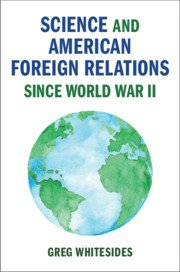 Dr. Greg Whitesides celebrated the release of his new book, Science and American Foreign Relations Since World War II (Cambridge University Press) in December of 2018. The sciences played a critical role in American foreign policy after World War II. From atomic energy and satellites to the green revolution, scientific advances were central to American diplomacy in the early Cold War, as the United States leveraged its scientific and technical pre-eminence to secure alliances and markets. The growth of applied research in the 1970s, exemplified by the biotech industry, led the United States to promote global intellectual property rights. Priorities shifted with the collapse of the Soviet Union, as attention turned to information technology and environmental sciences. Today, international relations take place within a scientific and technical framework, whether in the headlines on global warming and the war on terror or in the fine print of intellectual property rights. Science and American Foreign Relations Since World War II provides the historical background necessary to understand the contemporary geopolitics of science. Fredrik Logevall of Harvard University wrote that “Whitesides shows with great clarity and skill how the United States leveraged its scientific and technical expertise to help other nations but also to advance the perceived needs of US foreign policy.” Whitesides excels in merging the disciplines of history, science, and foreign relations, making Science and American Foreign Relations Since World War II a must read. To further explain the topics found in his book, Professor Whitesides started blogging for Cambridge University Press. His first blog post, "Chang'e-4 and U.S./Chinese Relations in Space," discussed the difficulties of regulating foreign nations' activities in space. For more information or to read this blog post, click here.
Dr. Greg Whitesides celebrated the release of his new book, Science and American Foreign Relations Since World War II (Cambridge University Press) in December of 2018. The sciences played a critical role in American foreign policy after World War II. From atomic energy and satellites to the green revolution, scientific advances were central to American diplomacy in the early Cold War, as the United States leveraged its scientific and technical pre-eminence to secure alliances and markets. The growth of applied research in the 1970s, exemplified by the biotech industry, led the United States to promote global intellectual property rights. Priorities shifted with the collapse of the Soviet Union, as attention turned to information technology and environmental sciences. Today, international relations take place within a scientific and technical framework, whether in the headlines on global warming and the war on terror or in the fine print of intellectual property rights. Science and American Foreign Relations Since World War II provides the historical background necessary to understand the contemporary geopolitics of science. Fredrik Logevall of Harvard University wrote that “Whitesides shows with great clarity and skill how the United States leveraged its scientific and technical expertise to help other nations but also to advance the perceived needs of US foreign policy.” Whitesides excels in merging the disciplines of history, science, and foreign relations, making Science and American Foreign Relations Since World War II a must read. To further explain the topics found in his book, Professor Whitesides started blogging for Cambridge University Press. His first blog post, "Chang'e-4 and U.S./Chinese Relations in Space," discussed the difficulties of regulating foreign nations' activities in space. For more information or to read this blog post, click here.
Dr. Greg Whitesides Science and American Foreign Relations Since World War II
